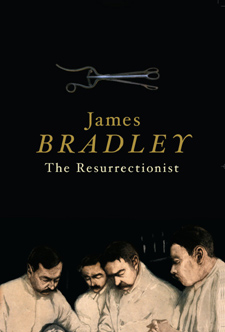In nineteenth century London "resurrectionist' was the name given to those who raised the dead. It was a profession, of sorts, for the strong of back and the morally suspect. For these resurrections were not from death to life but from the grave to the operating table.
The Resurrectionist is James Bradley's long awaited third novel. This gothic-style drama takes the reader into the gruesome and seedy world of 1826 London where those who would study anatomy and disease must bargain with grave-robbers and villains.
Orphaned at a young age, the penniless Gabriel Swift becomes a ward of a local clergyman. Despite being treated with love and kindness, Gabriel never allows himself to care for his adopted father. Through his guardian he becomes apprenticed to one of the city's leading anatomists and doctors, Mr Edwin Poll.
Under Mr Poll's watchful eye Gabriel learns the peculiarities of the human body in stomach-churning detail. But necessity dictates that Gabriel soon becomes accustomed to the smell and sight of the dead.
While the offer of a steady friendship exists with the senior apprentice, Robert, it is to Mr Poll's partner " the gregarious and high living Charles de Mandeville " that Gabriel is drawn. Together with Charles' dubious friends, Gabriel becomes enticed by the excitement of London's nightly offerings and addicted to opium and alcohol.
Despite his attempts at integrity, Gabriel soon succumbs to inducements of opium and the sleazy world which de Mandeville frequents. Falling foul of Mr Poll, he is dismissed and finds himself in the thrall of rival resurrectionists. Through them he learns that there is more than one way of securing a corpse.

James Bradley conjures a pulsing, seething city in his grimy vision of London. Grotty, immoral and violent, it is a claustrophobic, lonely world where human life is worth little and compassion is a stranger.
The second part of the novel is set some ten years later in rural NSW. A former convict teaches art to women and children and spends his hours alone. But despite the openness of the landscape and newness of the immigrants' and convicts' settlement, the social expectations are as demanding and damning as in England. Social acceptability is a tenuous thing. As one character reflects, "we are none of us without a past". Yet his social circle are both judgemental and self-righteous.
Grim, visceral and often brutal, The Resurrectionist is a moody and intense work of fiction. James Bradley is a deft artisan of language; his lyrical style of prose has become stronger with each novel, his writing urgent and compelling.
The Resurrectionist deals with death, life and rebirth. But as the characters in the story discover, once mired in sin it is impossible to escape its grasp. That others judge and shun is not really the issue. It is the damage wrought on oneself with which James Bradley is particularly interested. It is a keen observation.
While we might reinvent our exterior we cannot escape who we are and what we have done. We cannot undo our wrongs or make right what we have failed to do. Yet the burden of our pasts can be heavy; like Gabriel, many of us long to be free of what we have done and who we have become. Christians believe that our past is a burden that we need not carry. The work of Christ in dying put to death the hold of sin over us and wiped out the crimes and omissions of those who would trust in him. His resurrection was not from the grave to the table but from the grave to life. His resurrection broke the power of death; for just as he was raised to life so too will we be raised to life.















